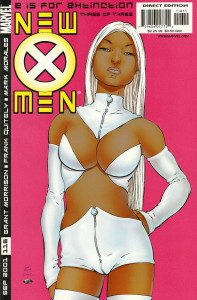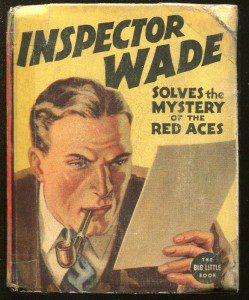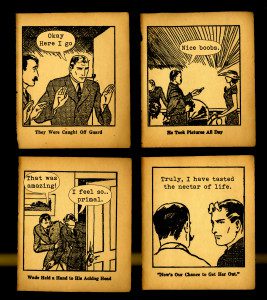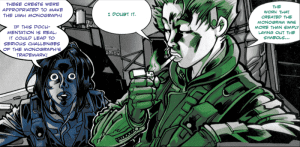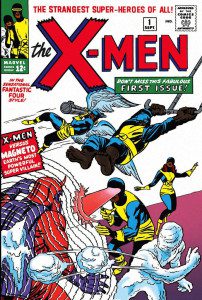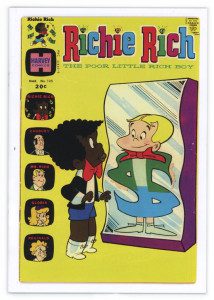The New York Comics & Picture-Story Symposium is a weekly forum for discussing the tradition and future of text/image work. Open to the public, it meets Monday nights at 7-9 p.m. EST in New York City. Presentations vary weekly and include everything from historical topics and technical demonstrations to creators presenting their work. Check out upcoming meetings here.
On Monday, June 16th, at the 88th New York Comics Symposium, R. Orion Martin presented on and then led an enthusiastic discussion about appropriated comics, what they mean, and what they can do.
Martin’s talk on appropriation in comics was divided into three parts: definition, works, and “what it means.”
Martin first explained both appropriation of content and the appropriation of materials. Examples of the former include the Batman parody, Mark of the Bat, by Josh Simmons, and Bartkira, a retelling of Akira with Simpsons characters that, as Martin pointed out, “falls under anything that can exist, will exist.” These comics borrow the tropes and content of established comics for their own purposes, either as parody or homage, and often as some of both. The next type of comics were those that borrow the actual materials of existing works to create something wholly new in tone or purpose. The first example offered was the popular Garfield Minus Garfield webcomic that took existing Garfield strips and rendered them absurd and existentially charged by removing any trace of the eponymous cat.
Martin then went on to discuss his own work. He was interested in writing comics but frustrated by both his own lack of art skills and his inability to convince others to illustrate his ideas. He, therefore, took a vintage copy of Inspector Wade Solves the Mystery of the Red Aces, an illustrated Big Little Book from 1937, and sliced out the pictures. He felt they had almost been designed to accommodate word bubbles, so they were perfect to add his own text to—text that subverted and yet still echoed the tone and content of the original.
Martin pointed to similarities between “Masculine,” as he titled the appropriation of the Inspector Wade illustrations, and the “Penny Arcade Project,” an English language teaching exercise invented in Japan, which took the webcomic Penny Arcade’s strips and removed text so children could fill in dialogue of their own invention.
Martin also discussed his next comics project, “Red and Yellow,” where he borrows panels from a variety of sources and stitches them together to create new pages and an original story of his own. He lays colored filters over characters to create continuity through the variously sourced panels. For example, a yellow overlay is meant to signify the same character despite different rendering styles or even panel-to-panel variations in race and gender. Here again, as in the “Masculine” comic, Martin found that it was hard to escape the original content, and wondered how successful he has been at defying any sort of gender and race definitions for the characters in his story. Overall though, Martin has found it is a good way for him to experiment with complex stories and composition.
And it brought him to his next project, “X-Men of Color.” Martin discussed the issue of projecting ourselves onto the images we see and the idea of a “white default.” For Martin, there is a huge problem with the fact that while X-Men comics are often offered up as a metaphor for the Civil rights movement, the stories still revolve around a cast of characters that are mostly white and male. Professor Xavier and Magneto are often seen as stand-ins for two of the greatest black leaders in the civil right movement of the 60s, Martin Luther King, Jr. and Malcom X, so it is a heavy irony that their counterpoints are distinctly patrician, Caucasian males in the comic books. For Martin, even though the comic has been used to champion a variety of minority rights issues—including gay rights and the anti-apartheid movement—the metaphor is inherently corrupted by the heteronormative and racially homogenous casting of its main characters. So in “X-Men of Color,” Martin set out to explore how skin color in the rendering of these characters affects the content of the comics. He recolored some of the more iconic X-Men covers and panels, portraying, amongst others, Cyclops, Jean Grey, Wolverine, and Emma Frost as people of color, challenging the reader’s assumptions and hopefully righting what Martin sees as a wrong.
Martin concluded his presentation with three questions for the audience:
Have you ever experimented with other people’s images?
Whose work is this?
Have you ever seen a version of an appropriation that helped you better understand the original work?
This sparked a lively and intense roundtable discussion about not only race issues in X-Men and appropriated comics, but also about ownership, copyright, cultural appropriation, and who is allowed to portray and draw what.
A number of other appropriated comics were discussed, including Josh Bayer’s Suspect Device and Soner On’s Richie Rich artwork. The talk expanded beyond comics into the nature of appropriation in the fine art world, including the work of the Situationalists, Roy Lichtenstein, and artist Sherry Levine. Dan O’Neil’s legal battles with Disney were brought up as well, in addition to the myriad of artists who lovingly “steal” copyrighted material from the monolithic cartoon empire. R. Sikoriak, who is well known for his Masterpiece Comics, was present at the talk and gave a brief presentation of his exhaustively researched appropriation of 50s era Batman comics to re-tell Dostoevsky’s Crime and Punishment. Ed Piskor’s Hip Hop Family Tree and Ben Marra’s Gangster Rap Posse were also brought up and compared in terms of tone and content. Musical appropriation was discussed (Girl Talk, De La Soul), including the nature of hip-hop music and the characters used and exploited by rap artists and how it may or may not be like the WWF. The group also noted that the Internet has helped spawn a vast trove of appropriation via fan art that touches on many of the issues Martin brought up: race, identity and sexuality (for example “The Hawkeye Initiative”).
The wide range of topics discussed—everything from Johnny Ryan to Katy Perry—is a testament to the ways in which seemingly distinct cultures intersect, and to the moving line between creator and consumer as well as the always blurring lines between artistic license, fair use, plagiarism, homage, parody, commentary, and satire.
***
Image Credits:
Image 1: Emma Frost from “X-Men of Color,” R. Orion Martin, 2013
Image 2: Inspector Wade Solves the Mystery of the Red Aces, Big Little Book, 1937
Image 3: “Masculine,” R. Orion Martin
Image 4: “Red and Yellow”, R. Orion Martin, 2012
Image 5: X-Men, first issue from “X-Men of Color,” R. Orion Martin, 2013
Image 6: Soner On, “Richie Rich”, 2011
***
About the author: Sophia Wiedeman is a comic artist and author of The Lettuce Girl series of comics as well as the Xeric-winning graphic novel The Deformitory. She lives and draws in New York city. You can see her work at sophiadraws.com

